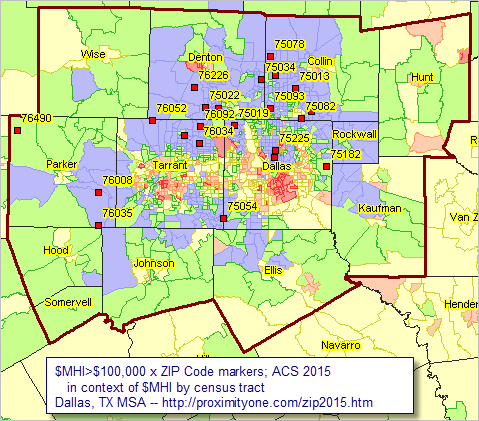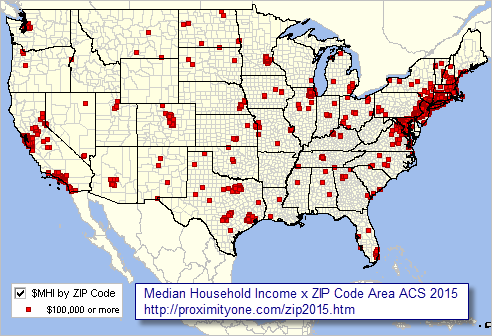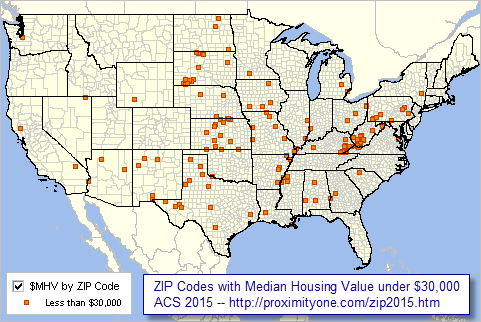

|
|
ACS 2015 ZIP Code Demographic-Economic Characteristics
Order the ACS 2015 ZIP Code Area Demographic-Economic Datasets Click the Buy button to buy the ACS 2015 ZIP Code Area Demographic-Economic Datasets. Download these four datasets in Excel structure for use on your computer. Each file contains a records for each ZIP code area. Items are described in the four scroll sections below.
AGE AND GENDER
D001 Total population D002 Male D003 Female D004 Under 5 years D005 5 to 9 years D006 10 to 14 years D007 15 to 19 years D008 20 to 24 years D009 25 to 34 years D010 35 to 44 years D011 45 to 54 years D012 55 to 59 years D013 60 to 64 years D014 65 to 74 years D015 75 to 84 years D016 85 years and over D017 Median age (years) D018 18 years and over D019 21 years and over D020 62 years and over D021 65 years and over D022 18 years and over D023 Male D024 Female D025 65 years and over D026 Male D027 Female RACE D028 Total population D029 One race D030 Two or more races D031 One race D032 White D033 Black or African American D034 American Indian and Alaska Native D035 Cherokee tribal grouping D036 Chippewa tribal grouping D037 Navajo tribal grouping D038 Sioux tribal grouping D039 Asian D040 Asian Indian D041 Chinese D042 Filipino D043 Japanese D044 Korean D045 Vietnamese D046 Other Asian D047 Native Hawaiian and Other Pacific Islander D048 Native Hawaiian D049 Guamanian or Chamorro D050 Samoan D051 Other Pacific Islander D052 Some other race D053 Two or more races D054 White and Black or African American D055 White and American Indian and Alaska Native D056 White and Asian D057 Black or African American and American Indian and Alaska Native Race alone or in combination with one or more other races D058 Total population D059 White D060 Black or African American D061 American Indian and Alaska Native D062 Asian D063 Native Hawaiian and Other Pacific Islander D064 Some other race HISPANIC OR LATINO AND RACE D065 Total population D066 Hispanic or Latino (of any race) D067 Mexican D068 Puerto Rican D069 Cuban D070 Other Hispanic or Latino D071 Not Hispanic or Latino D072 White alone D073 Black or African American alone D074 American Indian and Alaska Native alone D075 Asian alone D076 Native Hawaiian and Other Pacific Islander alone D077 Some other race alone D078 Two or more races D079 Two races including Some other race D080 Two races excluding Some other race, and Three or more races D081 Total housing units DP2 -- Social Characteristics Items sample XLS file
HOUSEHOLDS BY TYPE
S001 Total households S002 Family households (families) S003 With own children of the householder under 18 years S004 Married-couple family S005 With own children of the householder under 18 years S006 Male householder, no wife present, family S007 With own children of the householder under 18 years S008 Female householder, no husband present, family S009 With own children of the householder under 18 years S010 Nonfamily households S011 Householder living alone S012 65 years and over S013 Households with one or more people under 18 years S014 Households with one or more people 65 years and over S015 Average household size S016 Average family size RELATIONSHIP S017 Population in households S018 Householder S019 Spouse S020 Child S021 Other relatives S022 Nonrelatives S023 Unmarried partner MARITAL STATUS S024 Males 15 years and over S025 Never married S026 Now married, except separated S027 Separated S028 Widowed S029 Divorced S030 Females 15 years and over S031 Never married S032 Now married, except separated S033 Separated S034 Widowed S035 Divorced FERTILITY S036 Number of women 15 to 50 years old who had a birth in the past 12 months S037 Unmarried women (widowed, divorced, and never married) S038 Per 1,000 unmarried women S039 Per 1,000 women 15 to 50 years old S040 Per 1,000 women 15 to 19 years old S041 Per 1,000 women 20 to 34 years old S042 Per 1,000 women 35 to 50 years old GRANDPARENTS S043 Number of grandparents living with own grandchildren under 18 years S044 Grandparents responsible for grandchildren Years responsible for grandchildren S045 Less than 1 year S046 1 or 2 years S047 3 or 4 years S048 5 or more years S049 Number of grandparents responsible for own grandchildren under 18 years S050 Who are female S051 Who are married SCHOOL ENROLLMENT S052 Population 3 years and over enrolled in school S053 Nursery school, preschool S054 Kindergarten S055 Elementary school (grades 1-8) S056 High school (grades 9-12) S057 College or graduate school EDUCATIONAL ATTAINMENT S058 Population 25 years and over S059 Less than 9th grade S060 9th to 12th grade, no diploma S061 High school graduate (includes equivalency) S062 Some college, no degree S063 Associate's degree S064 Bachelor's degree S065 Graduate or professional degree S066 Percent high school graduate or higher S067 Percent bachelor's degree or higher VETERAN STATUS S068 Civilian population 18 years and over S069 Civilian veterans DISABILITY STATUS OF THE CIVILIAN NONINSTITUTIONALIZED POPULATION S070 Total Civilian Noninstitutionalized Population S071 With a disability S072 Under 18 years S073 With a disability S074 18 to 64 years S075 With a disability S076 65 years and over S077 With a disability RESIDENCE 1 YEAR AGO S078 Population 1 year and over S079 Same house S080 Different house in the U.S. S081 Same county S082 Different county S083 Same state S084 Different state S085 Abroad PLACE OF BIRTH S086 Total population S087 Native S088 Born in United States S089 State of residence S090 Different state S091 Born in Puerto Rico, U.S. Island areas, or born abroad to American parent(s) S092 Foreign born U.S. CITIZENSHIP STATUS S093 Foreign-born population S094 Naturalized U.S. citizen S095 Not a U.S. citizen YEAR OF ENTRY S096 Population born outside the United States S097 Native S098 Entered 2010 or later S099 Entered before 2010 S100 Foreign born S101 Entered 2010 or later S102 Entered before 2010 WORLD REGION OF BIRTH OF FOREIGN BORN S103 Foreign-born population, excluding population born at sea S104 Europe S105 Asia S106 Africa S107 Oceania S108 Latin America S109 Northern America LANGUAGE SPOKEN AT HOME S110 Population 5 years and over S111 English only S112 Language other than English S113 Speak English less than "very well" S114 Spanish S115 Speak English less than "very well" S116 Other Indo-European languages S117 Speak English less than "very well" S118 Asian and Pacific Islander languages S119 Speak English less than "very well" S120 Other languages S121 Speak English less than "very well" ANCESTRY S122 Total population S123 American S124 Arab S125 Czech S126 Danish S127 Dutch S128 English S129 French (except Basque) S130 French Canadian S131 German S132 Greek S133 Hungarian S134 Irish S135 Italian S136 Lithuanian S137 Norwegian S138 Polish S139 Portuguese S140 Russian S141 Scotch-Irish S142 Scottish S143 Slovak S144 Subsaharan African S145 Swedish S146 Swiss S147 Ukrainian S148 Welsh S149 West Indian (excluding Hispanic origin groups) COMPUTERS AND INTERNET USE S150 Total households S151 With a computer S152 With a broadband Internet subscription ZIP Code Areas with MHI $100,000 or More; Dallas, TX Metro Area Analyzing economic prosperity patterns using combined types of small area geography ... the following graphic shows ZIP code areas a red markers with the median household income or $100,000 or more in context of median household income by census tract thematic pattern. Click graphic for larger view with more detail. Expand browser window for best quality view. Use CV XE GIS software and associated GIS project to develop variations of this view for your areas of interest. .  - view developed with CV XE GIS software. This section reviews measures of economic prosperity for all ZIP code areas. These data were released in December 2016. This section updates with new data December 2017. See the list of all ZIP ccdes showing population, housing and economic characteristics in the interactive table shown below. Use the interactive table to view, rank, compare and query ZIP code attributes. Examining demographic-economic characteristics by ZIP code is important for several reasons. We are familiar with our own ZIP codes as a geographic location. We tend to be interested in our area compared to other areas. ZIP codes provide an easy way to do that. Also, many secondary data resources are tabulated by ZIP code area; some important data are only available by ZIP code. See more about ZIP Code areas. Resources & Methods to Examine Small Area Demographics • See related ZIP Code Demographic-Economic Interactive Tables .. extended subject matter • See related Census Tract Code Demographic-Economic Interactive Tables • Examine ZIP Code Urban/Rural Characteristics • Examine ZIP Code Business Establishment patterns • Examine ZIP Code Housing Price Index patterns • Join us in the weekly Data Analytics Lab Sessions .. reviewing applications using these and related data. ZIP Code Areas with $MHI $100,000 or More The following graphic shows ZIP code areas as red markers having median household income or $100,000 or more. Click graphic for larger view with more detail. Expand browser window for best quality view. Use CV XE GIS software and associated GIS project to develop variations of this view; integrate other data; select alternative ACS 2015 subject matter.  - view developed with CV XE GIS software. Click graphic for larger view. ZIP Code Areas with $MHV Less than $30,000 The following graphic shows ZIP code areas as orange markers having median housing value of less than $30,000. Click graphic for larger view with more detail. Expand browser window for best quality view. Use CV XE GIS software and associated GIS project to develop variations of this view; integrate other data; select alternative ACS 2015 subject matter.  - view developed with CV XE GIS software. Click graphic for larger view. Using the ZIP Code Areas Table & Data Use the interactive table below to view, rank, compare, query demographic-economic attributes of ZIP code areas. Purchase the data file (item #Z2015DE) to use with spreadsheet or other software -- Excel file with same items/structure as shown in table. Compute percentages and other values. Perform other types of queries. Integrate other data. ZIP Code Areas: Population & Economic Prosperity -- Interactive Table Use the interactive table shown below to examine attributes of ZIP Code areas. Table initially sorted by ZIP Code. Click column header to sort; again to sort other direction. See more usage notes below table. See related demographic-economic interactive pages Using the Interactive Table • Click ShowAll between queries/filters. • -1 value indicates data not available. • Click on a column header to sort on that column; click column header again to sort in other direction. • Click ShowAll button to show all tabulation areas and restore full set of data view. • Click State to select on geographies in a selected state (click ShowAll between selections). • ZIP Code Min & Max> button -- select a ZIP Code range .. click to show all ZIP code areas in min & max edit box range. .. enter the low value ZIP code in the left edit box. .. click "ZIP Code Min & Max" button to show these ZIPs. .. note that 22300 and 22399 will show all 223 three digit ZIPs. Find "relevant" ZIPs for a city by Find City. • Click ShowAll between queries/filters. Items in Table/Dataset - ZIP - City - State USPS - Total Population - Race - White alone - Race - Black alone - Race - American Indian and Alaska Native alone - Race - Asian alone - Race - Native Hawaiian and Other Pacific Islander alone - Race - Some other race alone - Race - Two or more races - Hispanic (any race) - $MHI - Median household income ($) - $MFI - Median family income ($) - Housing Units - total - Housing Units - occupied (households) - Housing Units - owner occupied - Housing value - $500,000 to $749,999 (owner occupied) - Housing value - $750,000 to $999,999 (owner occupied) - Housing value - $1,000,000 or more (owner occupied)K - Vacant housing units - Median housing value ($) - owner occupied units - Median gross rent ($) - renter occupied units Support Using these Resources Learn more about accessing and using demographic-economic data and related analytical tools. Join us in a Data Analytics Lab session. There is no fee for these one-hour Web sessions. Each informal session is focused on a specific topic. The open structure also provides for Q&A and discussion of application issues of interest to participants. ProximityOne User Group Join the ProximityOne User Group to keep up-to-date with new developments relating to geographic-demographic-economic decision-making information resources. Receive updates and access to tools and resources available only to members. Use this form to join the User Group. Additional Information ProximityOne develops geographic-demographic-economic data and analytical tools and helps organizations knit together and use diverse data in a decision-making and analytical framework. We develop custom demographic/economic estimates and projections, develop geographic and geocoded address files, and assist with impact and geospatial analyses. Wide-ranging organizations use our tools (software, data, methodologies) to analyze their own data integrated with other data. Follow ProximityOne on Twitter at www.twitter.com/proximityone. Contact ProximityOne (888-364-7656) with questions about data covered in this section or to discuss custom estimates, projections or analyses for your areas of interest. |
|
|